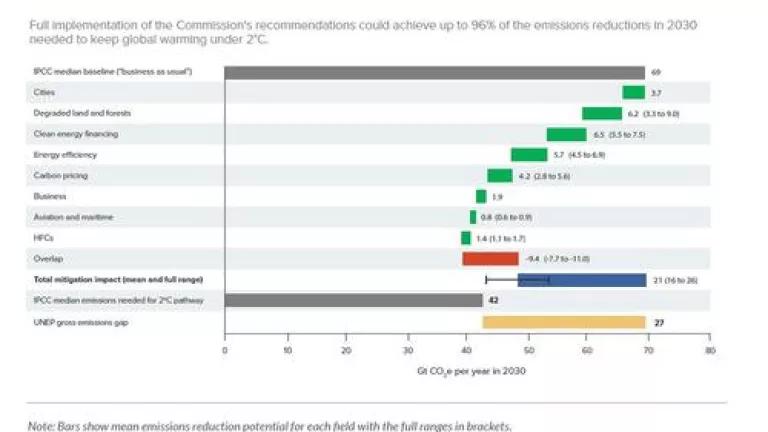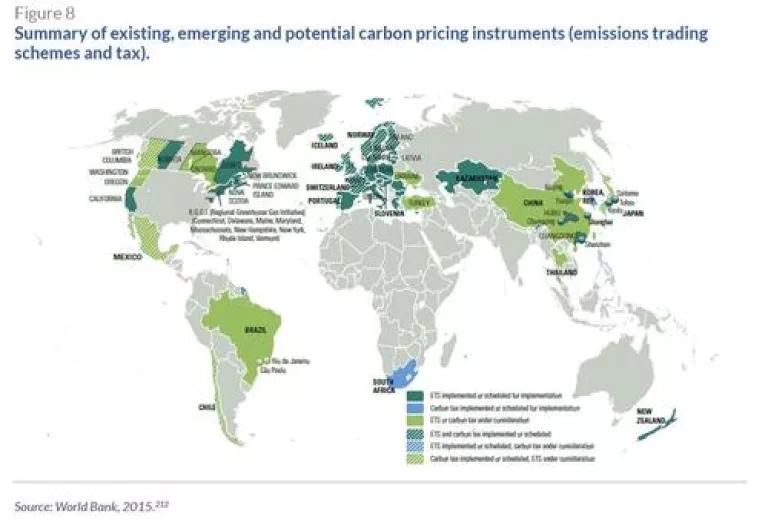
As countries announce their climate pledges ahead of the negotiations in Paris this December, many people are wondering whether the pledges are enough to keep global warming to under two degrees Celsius - and just as importantly, how to stimulate the actions needed beyond the national pledges. The New Climate Economy report, Seizing the global opportunity: partnerships for better growth and a better climate, provides recommendations for a groundswell of climate actions around the world. In total, implementation of the recommendations could deliver between 59 and 96 percent of the emissions reductions necessary by 2030 to keep global temperature increases below 2°C.
Co-chaired by economist Sir Nicholas Stern, the report found that greenhouse gas emissions could be limited while boosting economic growth. It calls for increased cooperation between governments, businesses, investors, cities and communities through "multi-stakeholder partnerships" to take concrete actions to reduce emissions.
The ten recommendations cover a variety of areas, with a focus on cities, land use and energy:
- Accelerate low-carbon development in the world's cities - the report recommends prioritizing policies and investments in low-emission transport, building efficiency, renewable energy and efficient waste management. Urban leaders from 80 cities around the world have committed to monitoring and cutting their cities' GHG emissions under a common accountability framework by signed on the "Compact of Mayors", which formed at the UN Climate Summit in 2014, and more efforts are expected. For instance, NRDC and the BEEC have been partners on demand side energy management in China for many years, proving that low carbon development can happen in even the fastest growing urban areas.
- Restore and protect agricultural and forest landscapes and increase agricultural productivity. Over 175 governments, companies, civil society institutions and indigenous peoples' groups endorsed the New York Declaration on Forests launched at the UN Climate Summit in September 2014, in which they committed to reduce natural forest loss by 50% at the end of the decade, and to end forest loss by 2030 while restoring more than 350 million hectares.
- Invest at least US$1 trillion a year in clean energy. The multilateral development banks, made up of the World Bank Group and regional development banks, provided US $24 billion to climate-related investments in 2013, and US$75 billion in total in the three years from 2011. As the REN21 report indicated, the cost of renewables is rapidly falling, while the investments by developed and developing countries have risen. For example, due to the dramatic reduction in the cost, solar PV modules now is about 80% cheaper than 2008, and have become completive with fossil fuels in many places.
- Raise energy efficiency standards to the global best. Countries are already on their way to improving energy efficiency standards through international platforms for collaboration. For example, over 60 countries have committed to reduce inefficient lighting by 2016 through the "en.lighten" initiative led by the United Nations Environment Programme and the Global Environment Facility, which the Global Fuel Economy Initiative is helping more than 20 countries improve vehicle fleet efficiency.
- Implement effective carbon pricing. Around the world, we've already seen carbon pricing instruments take off in developing and developed countries, provinces, states and cities. About 40 national and over 20 sub-national jurisdictions have now adopted or plan to implement a price on carbon, covering about 12% of annual global greenhouse gas emissions. For example, China has launched 7 regional pilot emissions trading schemes; France, Mexico and Chile are working on a carbon tax; and South Korea just launched one of the world's largest emissions trading schemes.

- Ensure new infrastructure is climate-smart. The international bank network has already made progress in this area. For example, multilateral development banks have worked for years on raising money and investing in climate-smart infrastructure.
- Galvanize low-carbon innovation. Important collaborations are happening worldwide. In November 2014, the US-China Clean Energy Research Center was expanded to cover joint research on clean vehicles, building energy efficiency and clean coal, in addition to several existing projects.
- Drive low-carbon growth through business and investor action. Companies around the world are increasingly integrating climate consideration into their business and investment strategies. Today, 53 of the Fortune 100 companies reported that they had saved US$ 1.1 billion in 2013 from energy efficiency, renewable energy and emissions reductions.
- Raise ambition to reduce international aviation and maritime emissions. Global aviation and shipping produce about 5% of global CO2 emissions, and by 2050 this is expected to rise to 10-32%. The International Maritime Organization (IMO) proposed two new standards which are expected to save an average of US$200 billion in annual fuel costs by 2030. The International Civil Aviation Organization (ICAO) might adopt a market-based measure (an emissions trading or offset scheme) that would both cut emissions and potentially generate finance for climate action or other purposes.
- Phase down the use of hydrofluorocarbons (HFCs).More than 100 countries now support regulating the highly potent HFC gases under the Montreal Protocol. This can help manage HFC production and consumption more effectively, and achieve emissions reductions of 1.1 to 1.7 gigatons of carbon dioxide equivalent per year by 2030. NRDC's work in India has promoted smart policies on HFCs, and the engagement of the Indian government in the Montreal Protocol discussions in recent months signals a shift in how developing countries with rapidly growing middle-class populations are viewing the climate challenge in light of high demand for products such as air conditioners and refrigerators.
Taken together, these policies can help our economies shift into a higher gear and reduce emissions across multiple sectors, in support of and in addition to the actions already pledged by national governments. The Paris climate negotiations are not the end of climate action, but more of a major milestone along the way to a new carbon-neutral economy. This transformation requires much more than just an international agreement and national targets. It will require bringing to scale the groundswell of action by government at all levels, as well as that of businesses, investors, and communities.
This post was co-authored with Wusi Fan.
